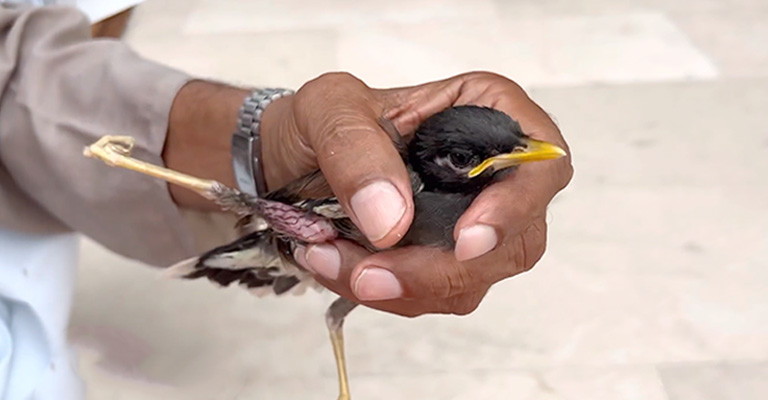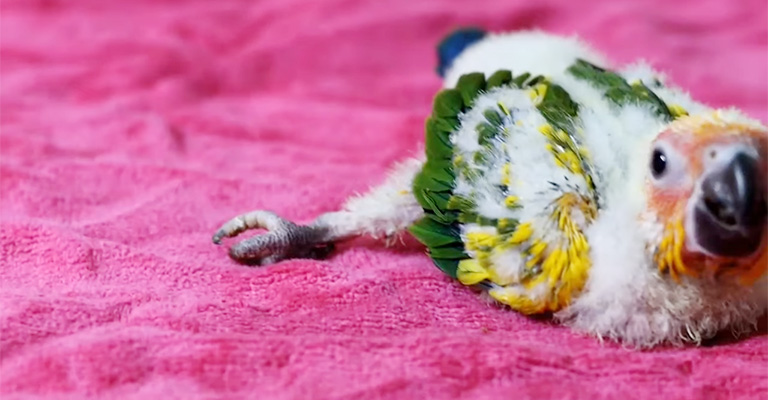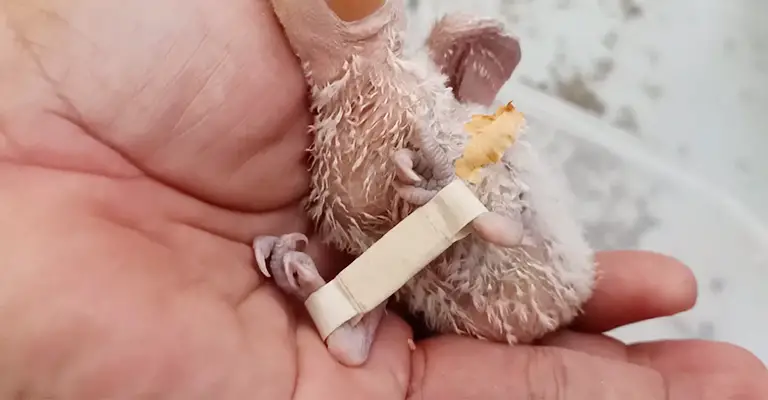A sprained leg in birds, also known as a ligament sprain, occurs when the ligaments that connect the bones in the leg become stretched or torn.
It can happen as a result of trauma, such as falling or flying into objects, overuse, or degenerative joint disease.
Recognizing and treating a sprained leg in birds is important because if left untreated, a sprained leg can lead to chronic pain, decreased mobility, and a decreased quality of life.
Additionally, if a bird is unable to move or use its leg properly, it can lead to other complications such as muscle atrophy, bone deformities, and even osteoarthritis.
Early diagnosis and treatment of a sprained leg can prevent these complications and help a bird make a full recovery.
By recognizing the symptoms of a sprained leg and seeking prompt treatment, bird owners can ensure that their feathered friends receive the proper care and have the best chance for a full recovery.

Symptoms of a Sprained Leg in Birds
Symptoms of a sprained leg in birds can vary depending on the severity of the injury. Some common signs to look for include.
Limping or Favoring One Leg
If a bird is limping or favoring one leg over the other, it may be a sign of a sprained leg. This can be observed by watching the birds walk or perch.
Swelling or Inflammation in the Leg
A sprained leg can cause swelling and inflammation in the affected area. This can be observed by gently examining the leg and comparing it to the other leg.
Difficulty or Reluctance to Move the Leg
If a bird is having difficulty or reluctance to move its leg, it may be a sign of a sprained leg. This can be observed by watching the bird move around its cage or perch.
Decreased Activity or Lethargy
A bird with a sprained leg may become less active or lethargic as a result of the pain and discomfort. This can be observed by watching the bird’s behavior and activity level.
Pain or Discomfort When the Leg is Touched
A bird with a sprained leg may experience pain or discomfort when the leg is touched. This can be observed by gently examining the leg and watching the bird’s reaction.
It’s important to note that not all birds will show all of these symptoms and some birds may have other symptoms not listed above. Any changes in the bird’s behavior or physical condition should be checked by a veterinarian.
Causes of a Sprained Leg in Birds

If you are well aware of the possible causes, you can easily find out the solution or the method of treatment. Make sure to check the below causes and figure out which one is bothering your bird.
Trauma or Injury From Falling or Flying Into Objects
Birds can sprain their legs as a result of falling or flying into objects. This can happen if the bird is kept in a small cage or if there are not enough perches or toys for the bird to play with.
Additionally, wild birds may also sprain their legs due to flying into objects such as windows or power lines.
Overuse or Repetitive Stress on the Leg
Overuse or repetitive stress on the leg is another common cause of a sprained leg in birds. This can happen if a bird is kept in a small cage and is not provided with enough space to move around, or if the bird is not given enough opportunities for exercise.
Nutritional Deficiencies or Metabolic Disorders
Nutritional deficiencies or metabolic disorders can also lead to a sprained leg in birds. For example, birds that are not provided with a balanced diet or that have a metabolic disorder such as obesity may be more susceptible to developing a sprained leg.
Osteoarthritis or Degenerative Joint Disease
Osteoarthritis or degenerative joint disease is a common cause of a sprained leg in older birds. These conditions are caused by the wear and tear on the joints over time and can lead to pain, stiffness, and difficulty moving the leg.
It’s important to note that there can be multiple causes of a sprained leg in birds, and it is essential to consult with an avian veterinarian for a proper diagnosis and treatment.
Treatment of a Sprained Leg in Birds

Now the question is how to treat your bird with such a problem. In this case, you can follow the below tips.
Rest and Confinement in a Small, Secure Area
The first step in treating a sprained leg in birds is to provide rest and confinement in a small, secure area.
This will help to reduce movement and stress on the affected leg, allowing it to heal. The bird should be kept in a small cage or a separate area away from other birds to prevent further injury.
Supportive Care
To provide additional support to the affected leg, the bird may be provided with a low perch or a leg brace. This will help to reduce stress on the leg and provide support to the affected joint.
Non-steroidal Anti-inflammatory Drugs (NSAIDs)
The bird may be prescribed non-steroidal anti-inflammatory drugs (NSAIDs) or pain medication to reduce pain and inflammation. These medications should be given as directed by a veterinarian.
Physical Therapy or Exercises
The bird may be prescribed physical therapy or exercises to help promote healing and regain strength in the affected leg. This can include range-of-motion exercises, massages, and other techniques to improve flexibility and mobility.
Nutritional Support and Supplements to Promote Healing
Proper nutrition is essential for healing and recovery. Birds with sprained legs may require a diet that is high in protein and essential vitamins and minerals to help repair and rebuild damaged tissues. They may also require supplements such as glucosamine and chondroitin which can help to protect and repair joint tissue.
It is important to consult with an avian veterinarian to develop a treatment plan that is best for the bird’s condition. The treatment plan may be adjusted as the bird’s condition improves or worsens.
Prevention of a Sprained Leg in Birds

There are some ways to prevent this issue. You can follow the below tips for the prevention methods of a sprained leg.
Providing a Safe and Spacious Environment
To prevent sprained legs in birds, it is important to provide a safe and spacious environment with plenty of perches and toys.
This will give the birds plenty of opportunities to move around and exercise, reducing the risk of falling or flying into objects. Additionally, having a variety of perches and toys will also help keep the bird mentally stimulated and reduce stress.
Regular Exercise and Opportunities for Flight
Regular exercise and opportunities for flight are important for preventing sprained legs in birds. Birds that are not given enough opportunities to fly or exercise may be more susceptible to developing a sprained leg.
This can be achieved by providing a large cage or aviary, and by taking the bird out of the cage for supervised flight time.
Monitoring for Signs of Injury
Monitoring for signs of injury or pain is important to detect a sprained leg early on and seek treatment as soon as possible.
Birds can hide their pain and if left untreated a sprained leg can lead to chronic pain, decreased mobility, and a decreased quality of life.
Providing a Balanced Diet and Ensuring Adequate Nutrition
Providing a balanced diet and ensuring adequate nutrition is important for preventing sprained legs in birds.
Birds that are not provided with a balanced diet or that have a metabolic disorder such as obesity may be more susceptible to developing a sprained leg. Additionally, proper nutrition can also help to promote healing in case of injury.
It’s important to note that sprained legs in birds can occur despite preventative measures and that it is crucial to be aware of the symptoms and seek treatment as soon as possible.
FAQs
The healing time for a sprained leg in birds can vary depending on the severity of the injury. Mild sprains may take a few weeks to heal while more severe sprains can take several months. It is important to follow the treatment plan prescribed by the veterinarian and to provide proper care and support during the healing process.
It depends on the severity of the injury. Birds with mild sprains may still be able to fly, but it is important to provide rest and confinement during the healing process. Birds with more severe sprains may not be able to fly at all until the injury has fully healed. It is important to consult with an avian veterinarian to determine the bird’s ability to fly.
No, over-the-counter pain medication is not safe for birds. Some medications can be toxic to birds and can cause serious side effects. It is important to consult with an avian veterinarian for proper diagnosis and treatment.
No, it is not safe to use a heating pad or hot water bottle on a bird’s sprained leg. Birds have a higher body temperature than mammals and are more susceptible to heat stroke. Cold compresses or ice packs can be used.
Conclusion
A sprained leg in birds is a common injury that can occur as a result of trauma, overuse, nutritional deficiencies, or degenerative joint disease. It is important for bird owners to be aware of the symptoms of a sprained leg.
Proper treatment and care are essential for a bird with a sprained leg to make a full recovery. This includes rest and confinement in a small, secure area, supportive care such as providing a low perch or leg brace, non-steroidal anti-inflammatory drugs (NSAIDs), or pain medication as prescribed by a veterinarian, physical therapy, or exercises.
In this case, prevention is also an important aspect of avoiding sprained legs in birds. It is important to provide a safe and spacious environment with plenty of perches and toys, regular exercise and opportunities for flight, monitoring for signs of injury or pain, providing a balanced diet, and ensuring adequate nutrition.
With proper treatment and care, birds with sprained legs can make a full recovery, and bird owners can play a vital role in ensuring that their feathered friends receive the best possible care. Best of luck.